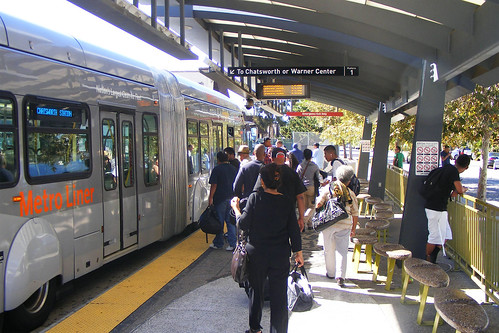
There are many questions surrounding Montgomery County's Bus Rapid Transit proposal, but there's just one the Planning Board will consider next Thursday: whether we should set aside room on our main streets for public transit. The answer is decidedly yes.
It's been 5 years since Councilmember Marc Elrich first proposed a countywide network of rapid bus routes. His idea has been reviewed, vetted and refined by transportation engineers, a task force of community and business leaders, the world's leading experts on BRT, and now county planners.
Today, the Planning Board is reviewing a draft of what's called the Countywide Transit Corridors Functional Master Plan, which envisions a 79-mile network containing 10 BRT routes across the county. While it's much smaller than what previous studies have proposed, it offers a realistic answer for our county's current and future traffic congestion.
I worked with Kelly Blynn of the Coalition for Smarter Growth to create a video about why we need BRT:
In some parts of the county, especially in the congested Downcounty, we don't have the room to move everyone in cars now, let alone in the future. Keep things the way they are and they'll get worse. Provide a dedicated lane for transit, as this plan proposes in many areas, and people will gain a fast, reliable alternative to sitting in traffic.
Don't get me wrong: I love driving, and I love my car. But I'd rather spend my time in the car having fun, not sitting in traffic because there's no better way to get around. Some will insist that transit doesn't work for them, and that's okay. However, there are places and times when transit is the best tool we have to get people moving, and we have to take advantage of it.
Expanding our transit network is really the only way that Montgomery County can continue to grow, and the county will grow, whether people want it to or not. This plan will provide improved transit service in areas where people already use it, like along Route 29 between Silver Spring and Burtonsville, where thousands of apartments were built in the 1970's and 1980's in anticipation of light-rail line that never materialized. And it will support future development in places like White Flint, where BRT along Rockville Pike will form the spine of a new urban center.
Of course, there have been a lot of questions raised about this proposal. Elected officials have asked how we'll pay for it. Residents are worried about impacts to their individual neighborhoods. And there's a larger, philosophical debate about Montgomery County's transition from being the "perfect suburbia" of 50 years ago to a slightly more urban place.
We're not going to answer these questions today, not do we have to. There are still a lot of details to consider, and there are smaller, incremental improvements we can make to our transit network sooner rather than later. What this plan can do, however, is begin a conversation about getting transit on equal footing with cars.
Growing up in Montgomery County, I was taught to value diversity. We may have different backgrounds, different perspectives, and different lifestyles, but we still come together to form one community. Building a transportation network that acknowledges that not everyone drives is a statement that we value all residents of Montgomery County, not just those who drive.
The Planning Board will hold a public hearing on the Countywide Transit Corridors Functional Master Plan this Thursday at 6pm at the Montgomery County Planning Department, 8787 Georgia Avenue in Silver Spring. To sign up to testify or send written comments, visit their website.
If you're interested in learning more about Montgomery County's BRT plan, the Action Committee for Transit is hosting a talk with Larry Cole, the county's head planner for BRT, at their monthly meeting this Tuesday at 7:30pm at the Silver Spring Civic Center, located at the corner of Ellsworth Drive and Fenton Street.

2 comments:
I think the answer to the BRT question is maybe, rather than yes. Before we can say yes, we need to know the capital and long term subsidy costs of BRT and whether there are other solutions that might work as well or better.
BRT may be a 20th century solution to a 21st century problem. In the 21st century do we really need to move people, or can we substitute moving information instead of moving people some of the time?
We know it doesn't take much reduction in the number of vehicles on the roads to greatly improve traffic. Just look at summer vacation time vs. during the winter or the days between Christmas and New Years.
Before we adopt BRT we should see if a solution like a gigabit internet network (like Google is building in the Kansas City area) would allow for enough real-time high participation video conferencing, virtual offices, etc. to eliminate the need for enough trips to solve the traffic problem.
Such a network would also set Montgomery County apart as a setting for technology businesses in a way BRT never would. It would also give us an advantage over Fairfax, etc.
Moving information rather than people is a "think out of the box" solution that ought to be examined before we rush into BRT.
Humans are social creatures, and they need face-to-face contact. No amount of technology will replace that. Besides, there are many jobs that require being there in person (both white- and blue-collar jobs) and activities that require, you know, actually leaving your house.
For the foreseeable future, we still have to go places, and we need a way to get there. A high-speed internet network won't solve our traffic problems now, let alone in the future.
Post a Comment